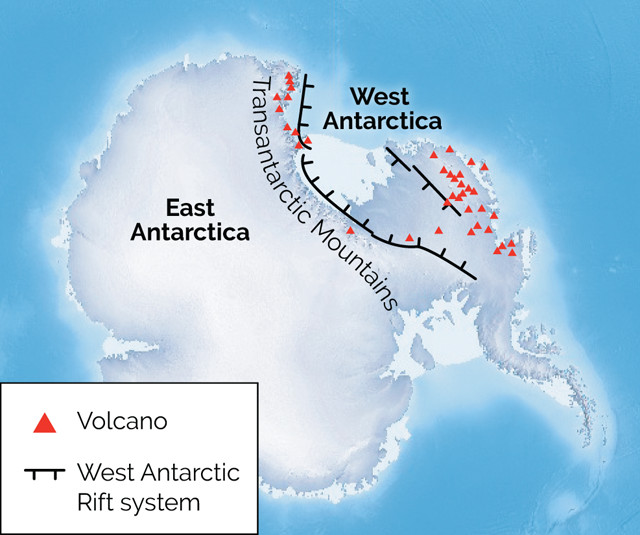
by Mary Caperton Morton Thursday, November 8, 2018

The West Antarctic Rift system split the continent into two plates for 200 million years before becoming inactive about 11 million years ago, after which the two plates drifted back together. The rift is responsible for the volcanoes that still exist on Antarctica. Credit: K. Cantner, AGI.
Studying Antarctica’s geology is difficult because of the continent’s remote location and extreme weather, and because most of it is buried under kilometers of ice. More than 100 volcanoes hint at the White Continent’s fiery history, however. Scientists have long known that Antarctica was once split into two plates along the West Antarctic Rift system. A new study provides information about when this rift system was last active, and the findings have implications for calculating plate tectonic movements around the planet.
To study the tectonic history of the West Antarctic Rift system, Roi Granot, of Ben-Gurion University of the Negev in Israel, and co-author Jérôme Dyment, of the Earth Physics Institute in Paris, collected marine magnetic geophysical data during two excursions on the French icebreaker L’Astrolabe in 2012 and 2016. The data enabled them to date rift features on the ocean floor surrounding the rift and calculate the relative motion between East and West Antarctica.
They found that the rift system was active as recently as 11 million years ago — 15 million years later than previous estimates. Once the east and west sides of the rift stopped moving, the plates fused into a single plate, joining the continent into one Antarctica. “The data clearly demonstrate that East and West Antarctica continued to move relative to one another up until recently,” says Chuck DeMets, a geophysicist at the University of Wisconsin-Madison, who was not involved in the study.
The finding may help explain why Antarctica has so many volcanoes hidden under its ice sheets — as many as 138, with dozens still active. “If the plate boundary died out 26 million years ago, it’s unlikely Antarctica would have as many active volcanoes,” Granot says. “The volcanism and heat flow we see today are the last vestiges of the heat driving those plate motions that stopped 11 million years ago.”
The findings also have implications for plate motions elsewhere, Granot says. “Antarctica is a key puzzle piece that connects the Pacific Plate to the rest of the world,” he says. “Now that we know how motion evolved in Antarctica over the last 26 million years, we can make more accurate calculations for motion within the entire Pacific Plate system.” For example, the additional 15 million years of motion along the Antarctic rift influences calculations of plate motions along all the plates connected to the Pacific Plate, including the North American and Australian plates. The findings are important “for understanding tectonic evolution around the Pacific Ocean, including the rise of New Zealand’s Alpine Mountains as well as motion along North America’s San Andreas Fault.”
The new time line for Antarctic plate motion fills some gaps in the worldwide plate tectonic puzzle, DeMets says. “When you assemble a jigsaw puzzle, you want all the pieces to come together without any gaps, but when we reconstruct the pieces of the jigsaw puzzle that involve the Pacific and North American plates over the last 20 million years, there ends up being a gap almost 65 kilometers long,” he says. “If you account for 15 million years of additional movement in Antarctica, more than half of that gap is suddenly accounted for. It’s always nice when new findings simplify long-standing puzzles.”
© 2008-2021. All rights reserved. Any copying, redistribution or retransmission of any of the contents of this service without the expressed written permission of the American Geosciences Institute is expressly prohibited. Click here for all copyright requests.